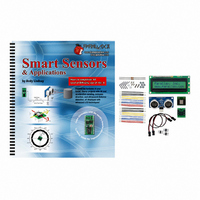28029 Parallax Inc, 28029 Datasheet - Page 206

28029
Manufacturer Part Number
28029
Description
KIT PARTS SMART SENSORS W/TEXT
Manufacturer
Parallax Inc
Datasheet
1.122-28029.pdf
(340 pages)
Specifications of 28029
Accessory Type
Parts Kit
Product
Microcontroller Accessories
Lead Free Status / RoHS Status
Contains lead / RoHS non-compliant
For Use With/related Products
BASIC Stamp® or Javelin Modules
Lead Free Status / RoHS Status
Lead free / RoHS Compliant, Contains lead / RoHS non-compliant
Other names
28029PAR
- Current page: 206 of 340
- Download datasheet (5Mb)
Page 194 · Smart Sensors and Applications
If the accelerometer measurements are slightly outside the 1875 to 3125 scale, it can
cause strange display symptoms. The
1875 is subtracted from each axis before it is scaled with the
the x-axis is 0 to 1250 is scaled to 0 to 20. For the y-axis, 0 to 1250 is scaled to 0 to 10.
As the y-axis tilt measurements decrease, the downward position of the cursor has to
increase. So instead of fitting 1875 to 3125 into 0 to 10, the program has to fit it into 10
to 0 instead. The statement
10. Likewise if y is 10 after scaling it becomes 0. If it's 9 after scaling it becomes 1, if
it's 8 after scaling, it becomes 2, and so on.
The last steps before repeating the loop in the Main Routine is to display the new asterisk
at its new
of the blinking asterisk.
Your Turn – A Larger Bubble
Displaying and erasing a group of asterisks like the one shown in Figure 5-13 can be
done, but compared to a single character, it’s a little tricky. The program has to ensure
that none of the asterisks will be displayed outside the plot area. It also has to ensure that
all of the asterisks will be overwritten with the correct characters from EEPROM. Here
is one example of how to modify BubbleGraph.bs2 so that it displays a 5-asterisk
coordinate indicator:
√
√
√
' Display asterisk at new cursor position.
DEBUG CRSRXY, x, y, "*"
PAUSE 50
Save BubbleGraph.bs2 as BubbleGraphYourTurn.bs2.
Add this variable declaration to the program’s Variables section:
temp
Replace the “Replace asterisk with background character” routine with this:
' Replace asterisk with background character (modified).
FOR temp = (x MIN 1 – 1) TO (x MAX 19 + 1)
NEXT
x
index = (22 * y) + temp + 1
READ index, char
DEBUG CRSRXY, temp, y, char
and
y
VAR
coordinates, then pause for another 50 ms to complete the “on” portion
Byte
y = 10 - y
MIN
and
solves this. If y is 0 after scaling, it becomes
MAX
operators prevent this problem. Also,
**
operator. The result for
Related parts for 28029
Image
Part Number
Description
Manufacturer
Datasheet
Request
R

Part Number:
Description:
Microcontroller Modules & Accessories DISCONTINUED BY PARALLAX
Manufacturer:
Parallax Inc

Part Number:
Description:
BOOK UNDERSTANDING SIGNALS
Manufacturer:
Parallax Inc
Datasheet:

Part Number:
Description:
COMPETITION RING FOR SUMOBOT
Manufacturer:
Parallax Inc
Datasheet:

Part Number:
Description:
TEXT INFRARED REMOTE FOR BOE-BOT
Manufacturer:
Parallax Inc
Datasheet:

Part Number:
Description:
BOARD EXPERIMENT+LCD NX-1000
Manufacturer:
Parallax Inc
Datasheet:

Part Number:
Description:
CONTROLLER 16SERVO MOTOR CONTROL
Manufacturer:
Parallax Inc
Datasheet:

Part Number:
Description:
BASIC STAMP LOGIC ANALYZER
Manufacturer:
Parallax Inc
Datasheet:

Part Number:
Description:
IC MCU 2K FLASH 50MHZ SO-18
Manufacturer:
Parallax Inc
Datasheet:














